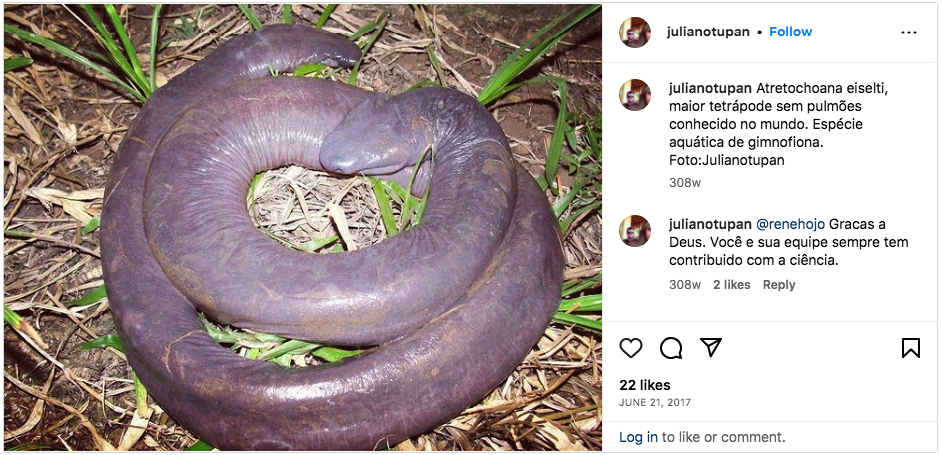The countless mysteries of the animal kingdom never fail to amaze us.
However, some animals shine brighter than the rest and possess the ability to quickly grab global attention because of their unique looks or extraordinary traits.
I must confess, upon seeing a picture of this peculiar “penis snake” for the first time, I genuinely believed it was a prank. To my astonishment, I later discovered that it is indeed a real creature. Come along with me as I uncover the fascinating story behind the viral photo that has left countless individuals horrified.

Over the years, objects shaped like phalluses have always managed to capture people’s attention and spark curiosity. Some time back, several images of a mysterious creature surfaced on the internet, leaving many in disbelief.
The fascinating and unique creature has a remarkable look, earning it various fitting names such as the “snake with a striking resemblance to a certain body part,” “sightless snake,” or the “giant snake.”
Actually, it’s not what you’re imagining.

Atretochoana eiselti, also known as the creature, surprises scientists as it falls into a distinct animal group but looks remarkably like a snake. This lungless tetrapod is the biggest of its kind and is actually an amphibian with closer ties to the salamander.
This rare creature, found exclusively in the Brazilian Amazon, was believed to have gone extinct until Sir Graham Hales and Sir Brian Doll stumbled upon it during their expedition in the late 1800s.
The first description of A. eiselti was not made public until 1968. It was later reclassified in 1996 as its own distinct genus named Atretochoana after further research and analysis.
The “penis snake,” a distinctive caecilian species, was found again in 2011 in the Amazonas. This rare creature is exclusive to the Amazon River and its main tributary, the Madeira River in Brazil. There have been no documented sightings of this species anywhere else besides this particular area.
In 2011, a fascinating family of critters with a phallic shape was found in Brazil’s Madeira River. This remarkable discovery eventually led to the viral images that captivated the internet a few years ago. These critters were stumbled upon during an inspection of a hydropower dam, which required the river to be drained.
Julian Tupan, a biologist working for the Santo Antonio Energy company in charge of constructing the dam, asserts that there is a lack of knowledge regarding the limbless, lungless frogs.

According to The Sun, he informed Estadao that out of the six we gathered, one passed away, three were set free into their natural habitat, and the remaining two were retained for research purposes.
Tupan emphasized that the “snakes” pose no threat and are unlikely to behave aggressively.
Although they may resemble snakes, these creatures are not reptiles and actually share a closer kinship with salamanders and frogs. It is believed that they obtain oxygen through their skin and likely sustain themselves by consuming small fish and worms, although no concrete evidence has been found yet.
The Amazon never fails to amaze with its incredible variety of reptiles and amphibians. There is always something new waiting to be uncovered.
A recent study published in the Brazilian scientific journal Boletim do Museu Paraense Emlio Goeldi: Ciências Naturais revealed that one of the species found in the riverbed was extensively documented. In the Madeira River, some of the animals were released back into their natural environment, while others were brought to the Emilio Goeldi Paraense Museum in Belem, Brazil.
The image that received the most shares was uploaded on Julian Tupan’s Instagram account, featuring an adult female A. eiselti measuring approximately 40 inches in length. Even though there is a great deal of interest in these captivating creatures, much remains unknown about them, and our knowledge of them is still quite limited.
Researchers are puzzled by an intriguing aspect of their dietary choices. It is believed that creatures with phallic forms consume tiny fish, worms, and other water-dwelling invertebrates. However, further investigation is necessary to validate this hypothesis.

Their breathing mechanism is still a puzzle as it is not clear how they manage to breathe. The discovery of the six specimens in 2011 further complicated this enigma. The fact that they were found in a location with limited access to cold, fast-flowing water makes it even more noteworthy. Considering that warmer water contains less oxygen, their ability to survive without lungs is truly extraordinary.
Recent findings suggest that this species has a wide range across the Brazilian Amazon and could potentially spread into Bolivia.
We are always amazed by the endless wonders and delightful surprises that nature has to offer. The beauty and mysteries of the natural world never cease to captivate us, whether it’s exploring the depths of the ocean or reaching the peaks of towering mountains.
Spread the word about this incredible tale on Facebook and inspire your loved ones to explore the mysteries of nature!

Leave a Reply